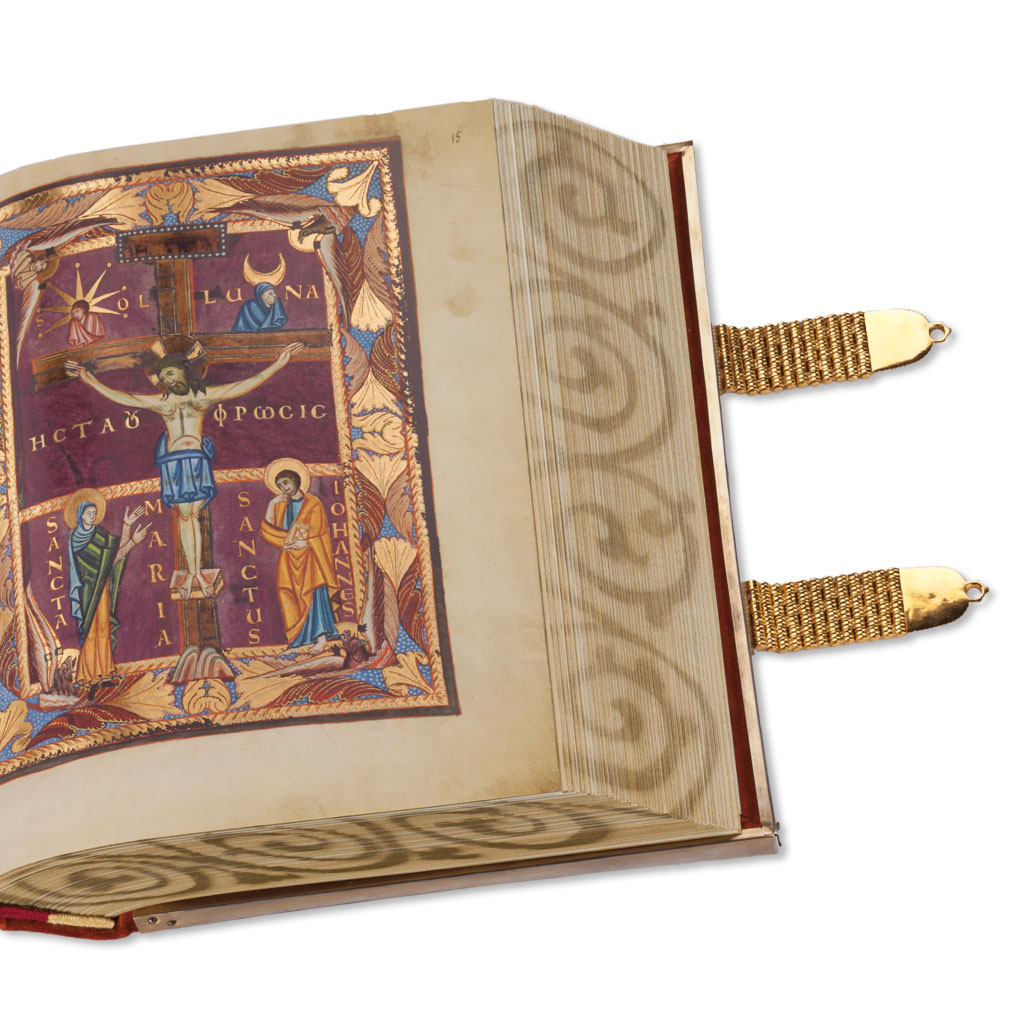Bavarian State Library, Munich, Clm 4456
Sakramentar Heinrichs II.
Ein Buch so eindrucksvoll wie die kaiserliche Krone
Henry II, later to become Emperor, ordered this sacramentary, one of the most important manuscripts of the Middle Ages, to be made. Both the miniatures which are richly clad with gold and silver decorations and also the full-page ornamental script mirror, underline Henry’s claim to authority as ‘ruler in the House of God’.

The Sacramentary of Henry II
Regensburg – Bamberg – Munich
Until today it is still unknown for which church or which monastery this magnificent Sakramentary was originally meant for. Should the manuscript accompany, together with the St Emmeram’s Codex Aureus, the solemn masses in the Regensburg Cathedral, or should the Sacramentary serve as missal in the Old Chapel of Henry’s Court Church for setting the liturgy? Almost 800 years the codex was one of the most significant treasures of the Bamberg Cathedral and by this belonged to the bishopric of Henry II.
The Sacramentary of Henry II
Bavarian State Library, Munich, Clm 4456
The sacramentary – a sumptuous gem, resembling an imperial crown
The sacramentary – a sumptuous gem, resembling an imperial crown
It was intended to be a particularly lavish volume which impressively underlined the claim to power of the emperor to be. The skins of around 100 sheep and calves were necessary in order to produce the parchment for the 179 bifolios of the splendid manuscript – accounting for 718 pages in the finished book. How much gold and silver was used for the execution of its painted and decorated miniature pages, the calendar pages, the pages containing the High Offices written in gold script, and the gold and silver initials is hard to tell – not to mention the splendid goldsmith’s binding which was added to underline the material value of this missal that was expressly made for the ruler himself.
This luxury binding made of gilded silver sheet metal and a precious ivory plate protects a work of art whose text was embellished by the Regensburg scribes with 343 initials up to 15cm high, 21 luminously imaginative marginal frames, and 14 illustrated pages that even today constitute a true highlight of German art.
Liturgical Book and Artwork
As all manuscripts of this kind the Sacramentary of Henry II contains all prayers, which are recited during the Holy Mass from the celebrating priest or bishop. These text parts, which contain richly with gold- and silver decorated initials in Ottonian style, follow an extensive sequence of images, full-page ornamental texts and a calendar written in golden letters.
The illuminated manuscript starts like a firework at the beginning of a great festival: Plates depicting the months of the year are followed by a coronation and throne picture of Henry II, expressing the very essence of how the last Saxon emperor saw an ideal ruler. Beside other noble pages Saint Gregory the Great is also honored with an imposing author’s picture. After a final page with the Lamb of God the actual Sacramentary commences, which hasn’t been written and illuminated on vellum any longer but on finest sheep parchment.
A sumptuous codex for a sacred emperor
The Sacramentary of Henry II is one of the last highlights of Ottonian illumination. Henry II ordered this book in Regensburg for the ceremonial celebration of the masses, while he still occupied the throne. The volume once was among the most beautiful gems ever kept at the Cathedral of Bamberg, a bishopric that Henry II had founded in 1007 and magnificently endowed with the finest treasures, among them his Sacramentary. The founding of the See of Bamberg was one of Emperor Henry’s major achievements. Through rich endowments, he turned it into a centre of spiritual and cultural development in Germany.
The Luxury Binding
The fine parchment leaves, lavishly painted with miniatures and initials alike, and the binding were intended to form a cohesive artwork. Although the volume was probably rebound a number of times, we may still assume that the individual elements of its cover were associated with the Sacramentary right from its original production – a Sacramentary, which is stylistic and functionally inseparably associated with the Codex Aureus of St Emmeram from the court school of emperor Charles the Bald.
The front cover of the volume shows a magnificent ivory plate framed with golden sheet metal, illustrating the same biblical events that are also pictured in the manuscript: the Crucifixion and below it the events of the Easter morning with the Three Marys at the empty Tomb.
No less impressive is the back cover of the book, which on a silver plate shows Pope Gregory the Great writing his text. He is inspired by the Holy Spirit who in the form of a dove seems to whisper in his right ear. Much like the author’s picture inside the painted book, this partly gilded silverwork expresses great harmony.
The facsimile – a collector’s item and masterpiece
The unique and complete facsimile edition of the Sacramentary of Henry II is published in only 333 hand-numbered copies. The facsimile volume comprises a total of 718 pages in the original format of 29.5 x 24.2 cm. The leaves have been trimmed in accordance with the original book and sewn by hand. We owe the museum restorer André Glauser and the specialized company commissioned by him the replica of the original binding.
The commentary volume
In a number of inspiring and easily understandable essays, reputed experts provide a wealth of information on the provenance, the function, and the artistic contents of the Sacramentary of Henry II. The commentary volume includes articles by Brigitte Gullath, Munich, Martina Pippal, Vienna, Stefan Weinfurter, Mainz, and Erich Renhart, Graz.
Another very important book of the Middle Ages, originating from the palace school of Charlemagne, is the Coronation Gospel..



